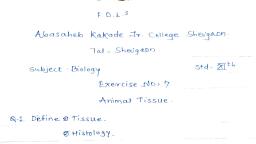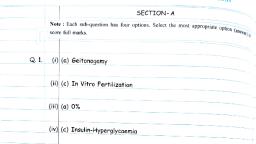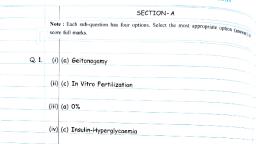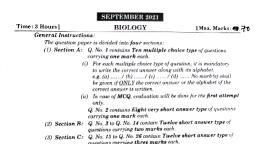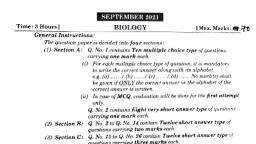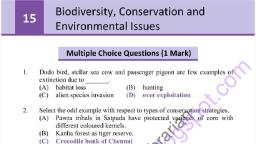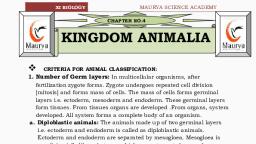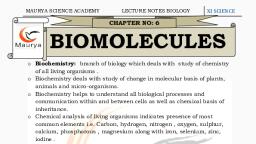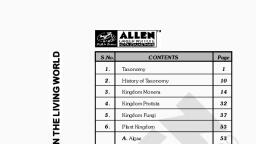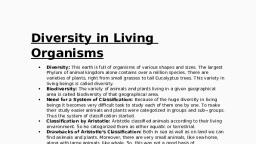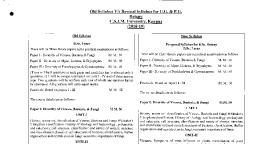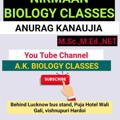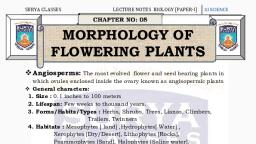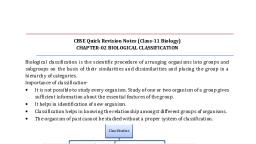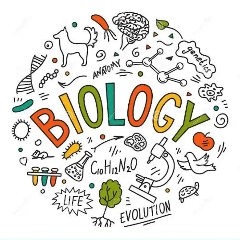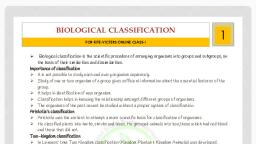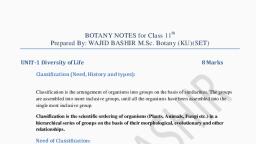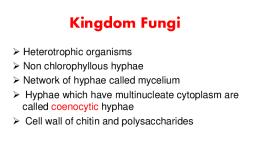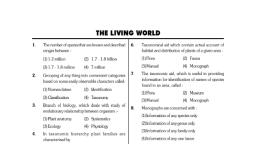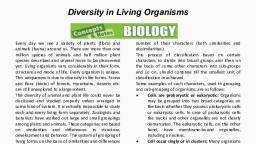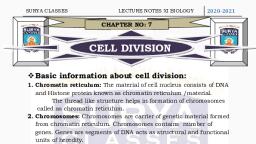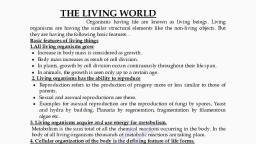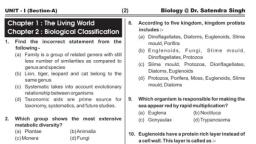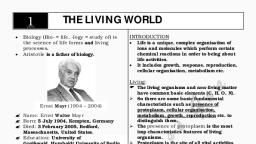Page 1 :
[], , XI BIOLOGY, CHAPTER NO.2, , SYSTEMATICS IN, LIVING ORGANISMS, o, , Systematics: It is branch of biology which deals with study of, similarities and differences among different kind of organisms., It also includes their identification, nomenclature and, classification, Systematics is the study of kind and diversity of organisms, and their comparative and evolutionary relationship., , o Taxonomy: [ Greek words Taxis- arrangement Nomous-law/rule], o Taxonomy means classification following certain rules and principles., The branch of biology which deals with collection, identification,, nomenclature, description and classification of plants and animals., A.P.de Candolle: Introduced term taxonomy, o Objectives/Significance of Systematics and Taxonomy :, 1. To know various kinds of organisms with their names, affinities,, geographical distribution, habits, characteristics and economical, importance., 2. Acts as reference system for scientific study of organisms., 3. Helps to demonstrate diversities of organisms., 4. Helps to study phylogenetic/evolutionary relationship, 5. Helps to provide scientific names /nomenclature for every, organism., , ❖, , Classification: Arrangement of organisms or groups of, , organisms in distinct categories on the basis of particular and well, established plan is called as classification., Classification based on similarities and dissimilarities among, the organisms., o A.P.de Candolle : Coined the term classification, o Need of classification :, 1. To study variations in shape and size of organisms., 2. To Study variations in habits and habitats of organisms., 3. To study variations in nutrition., 4. To remember characteristics of all organisms., 5. To explain unity of diversity., 6. To show relationship among various group of organisms., 7. Proper arrangement of living organisms., 8. Giving specific and scientific names of organisms., , 1, , SYSTEMATICS IN LIVING ORGANISMS I SIGN OUT BY DR. VIRESH SHELKE
Page 2 :
XI BIOLOGY, , [], , o Ways of classification :, 1. Artificial classification :, o The classification based, on easily observable, features and non, evolutionary features, like habits, color, form,, shape etc., o There is no relationship, between organisms, classified., o Example: Linnaeus, system of classification., , 2. Natural classification :, o It is based on, objectively, significant criteria, o Example :, Bentham and, Hooker’s system, of classification, , 3. Phylogenetic :, o It is based on common evolutionary, descent., o It often includes taxa and categories., o Each category is a unit of classification, and represents rank and commonly, termed as taxon., o Example : Engler and Prantles system of, classification, , ❖ Three Domains of life :, o Carl Woese [1990]: Used three domain systems for classifying living, organisms. Domain is a unit larger than kingdom in the system of, classification. All three domains have unique ribosomal RNA. Three, domain system based on differences in ribosomal RNA structure of, different groups of organisms. Ribosomal RNA is a molecular building, , 2, , SYSTEMATICS IN LIVING ORGANISMS I SIGN OUT BY DR. VIRESH SHELKE
Page 3 :
[], , XI BIOLOGY, , block for ribosome. Three domain system of classification consist of 3, domains and 6 kingdoms., Three domain system of classification, , Archea, Prokaryotes, , Kingdom, Archaebacteria, [ survive at high temp,, salinity , acidic conditions, cell wall without, peptidoglycan, Kingdom, Protista, [cell wall, made up of, cellulose ], , ❖, , Bacteria, , Eukarya, , Prokaryotes, , Eukaryotes, , Kingdom, Eubacteria, [cell wall made up of, peptidoglycan], , Kingdom, Fungi, [cell wall, made up of, chitin], , Kingdom, Plantae, [cell wall, made up of, true cellulose], , Kingdom, Animalia, [cell wall, is absent], , Chemotaxonomy:, , o Example : Classification of Protein, o It is biological, A. On the basis of residue:, classification, 1. Peptide:, method based on, 2. Dipeptide:, similarities and, 3. Tripeptide:, differences in, 4. Polypeptide:, structure of certain, B. On the basis of nature:, compounds., 1. Simple proteins: Histone protein (DNA),, o The classification, Zein protein (Maize), based on chemical, 2. Conjugated proteins: Lipoproteins, constituents of, ,Nucleoproteins Glycoprotein , Chromoprotein, organisms., , ❖, , Numerical Taxonomy:[Phenogram], , o This system based on, quantification of, characters and develops, an algorithm for, classification., o Basic aim is to create a, taxonomy using, numerical algorithms, .This system proposed by, Sokel and Sneath [1963], , 3, , SYSTEMATICS IN LIVING ORGANISMS I SIGN OUT BY DR. VIRESH SHELKE
Page 4 :
XI BIOLOGY, , ❖, , [], , Cladogram:, , o It is typical, branching pattern, o It represent, denoting a, comparision of, organisms and, their commom, ancestors., , ❖, , Phylogeny:, , o The evolutionary, relationship of organisms, is phylogeny., o It takes account of, morphological status as, well as relationship, between organisms., o It helps to understand, the evolution and focuses, on the similarities of, their metabolic, functioning., o Example: Woese's three, domain system,, Whittakar's five kingdom, system, , ❖, , DNA bar coding :, , o The new method of classification of any species based on its DNA, sequence., o It includes two basic steps, a. Collection of DNA barcode data of known species., b. Matching the barcode sequence of the unknown sample, against the barcode library for identification., o It helps to study newly identified species, o It helps to understand ecological and evolutionary relationships, between living beings., o It helps in protection of endangered species and natural resources,, o It is useful for pest control in agriculture, identification of disease, vector, authentication of natural health products., o It is also useful for identification of medicinal plants., , 4, , SYSTEMATICS IN LIVING ORGANISMS I SIGN OUT BY DR. VIRESH SHELKE
Page 5 :
XI BIOLOGY, , ❖, , [], , Taxonomic categories :, , o Taxon: Group of living organisms used to represent a concrete unit of, classification. A taxon is the taxonomic group of any rank in the, system of classification., o Category: Rank/level in the hierarchial classification of organisms., Various taxa are assigned definite categories according to their, taxonomic status. Kingdom is highest and species is lowest category., Categories are compulsory as well as facultative., , ❖, , Taxonomic Hierarchy: Scientific grouping of different, , taxonomic categories in a descending order on the basis of their rank, in classification is called as taxonomic hierarchy., o Hierarchy: Stepwise arrangement or box with in box system is, hierarchy. It provides appropriate place in framework of classification, of every organisms., , o Units of Classification / Hierarchy of taxonomic categories:, 1. Species: It is smallest and basic unit of classification. The members, of species show all similar characters. It is principal natural, taxonomic unit ranking below the genus. It is an indivisible, stable, and static unit. In modern taxonomy, sub division of species [ subspecies, varieties and populations] is also important., a. According to Linnaeus: A group of organisms which are similar, in their morphological characters is called morphospecies., b. According to Darwin : A group of organisms that can interbred, under natural conditions to produce fertile offsprings called as, biospecies/true species, c. According to Ernst Mayr: A group of actually or potentially, interbreeding natural population of closely resembling organisms., 2. Genus: Group of closely related species is called as genus., Genus is group of species bearing close resemblance to one another, in their morphological characters but they do not interbred, a. Monotypic genus : Genus having single species, b. Polytypic genus: Genus having many species., Example: Genus Panthera includes Tiger, leopard ,lion, 3. Family: Group of closely related genera., Example: Family Felidae includes leopards, tigers and lions and, family Canidae includes dog, wolf , mongoose, cat ., 4. Order/ Cohort : Group of closely related families showing definite, affinities, Example : Dogs and cat belongs to same order Carnivora., 5. Subclass: Group of closely related orders or different orders having, similar characters included in subclass., 6. Class: Group/Assemblage of closely related subclasses/ orders., , 5, , SYSTEMATICS IN LIVING ORGANISMS I SIGN OUT BY DR. VIRESH SHELKE
Page 6 :
XI BIOLOGY, , [], , Example: Carnivora [dogs cats and tigers] and primates [ Monkeys,, gorillas, gibbons] belongs to class mammalian., 7. Division/Phylum: Group of closely related classes. In animals, classification division is a sub unit of category Phylum., 8. Sub-kingdom: Group of closely related divisions/Phyla, 9. Kingdom: Group of closely related sub-kingdoms .Kingdom is, highest taxonomic category., Kingdom, Sub kingdom, Division/Phylum, Class, Subclass, Order, Family, Genus, Species, o Methods of Classification[Taxonomic Hierarchy] :, 1. Rosa sinesis / Hibiscus:, Category, Taxon, Remark, 1. Kingdom, Plantae, Multicellular, Eukaryotic, Autotrphs, 2. Sub-kingdom Phanerogames Seed producing flowering plants, 3. Division, Angiosperme, Ovules enclosed inside ovary, 4. Class, Dicotledonae, Two cotyledons in seed, 5. Sub class, Polypetalae, Free petals, 6. Series, Thalamiflorae, Floral whorls on thalamus, 7. Order, Malvales, Axile placentation, 8. Family, Malvaceae, Anatropous ovule, 9. Genus, Hibiscus/Rosa Red colored, 10. Species, Sinesis, -, , ❖, , Nomenclature :, , o Definition: The art of naming an object is called as nomenclature., o Types: 1. Vernacular names 2. Scientific Names, 1., , Vernacular/local/Common names: The names given to, organisms in a particular region and language by local people is, called as vernacular names, Advantages :, Disadvantages:, 1. Short, 1.Not universal, 2. Familiar, 2.Do not indicate proper relationship, 3. Easy to follow, 3.Creates problems in communication, 4. Creates confusion., , 2., , Scientific names: The names based on some criteria and, principles which are universal known as scientific names., To overcome the difficulties raised by vernacular names,, scientific names are constructed. Polynomial scientific names are, converted into binomial names by using binomial system of, nomenclature., , 6, , SYSTEMATICS IN LIVING ORGANISMS I SIGN OUT BY DR. VIRESH SHELKE
Page 7 :
XI BIOLOGY, , [], , o Carl Linnaeus : Introduced binomial system of nomenclature in his, book " Species Plantarum " in1753., o International Code of Botanical Nomenclature [ICBN] : also, accepts binomial nomenclature. ICUN is also known as Shenzhen, code and name changes as "International Code of Nomenclature for, Algae, Fungi And Plants [ICNAFP], o Advantages :, 1. Simple, meaningful, precise and standard., 2. Universally accepted., 3. Help to avoid confusion, 4. Easy to understand and remember, 5. Indicate phylogeny of organisms, 6. Helps to understand relationships [between org./group of org., , ❖, , Binomial System of Nomenclature :, , o Definition: A system of nomenclature of plants and animals in which, the scientific names consists of two words/epithets., o Carlous Linnaeus: Creator/father of nomenclature system., o Rules of Binomial nomenclature :, 1. Biological name: The name of genus and species written together, known as biological name., 2. Generic epithet: The generic name is simple noun which should, come first and always start with capital letter., 3. Specific epithet: The specific name is descriptive adjective which, should come later and always start with small letter., 4. Separate underline: Scientific names must be underlined separately, 5. Italic form: The scientific names must be printed in italic form., 6. Latin/Latinized language: The generic and specific names compsed, of Latin words., 7. Greek and Sanskrit words: Greek and Sanskrit words should be, accepted for binomial nomenclature but should be Latinized., 8. Number of letters: The generic as well as specific names should not, have less than 3 letters and more than thirteen letters., 9. Citation: Mentioning of authors name after species name is citation., Name of author is also written full or in abbreviated form after, the scientific name., 10. Repetition of specific epithet: The species name can be repeated, when the genera are different., 11. No repetition of Generic epithet /Names: Two generic names in, any kingdom cannot be same., 12. Synonyms: When single species is described under different, authors called as synonyms., , 7, , SYSTEMATICS IN LIVING ORGANISMS I SIGN OUT BY DR. VIRESH SHELKE
Page 8 :
XI BIOLOGY, , ❖, , [], , Kingdom System :, , o Carlous Linnaeus : Proposed two kingdom system i.e. Plantae and, Animalia, o Haeckel : Proposed third kingdom Protista, o Whittaker: Proposed five kingdom system i.e. Kingdom monera,, Protista, fungi, Plantae and Animalia., Whittaker used 4 criteria’s for classify organisms in, kingdom system i.e. cell organization, body organization, mode of, nutrition and ecological role., , KINGDOM, MONERA, , KINGDOM, PROTISTA, , KINGDOM, FUNGI, , 1. Nature, , Microscopic in, nature, , Microscopic in, nature, , 2. Habitat:, , Omnipresent, , Mostly aquatic, , 3. Cell, organization, 4. Body, organization, :, , Prokaryotic cell, [Nucleoid], a] Unicellular:, Eubacteria, b] Filamentous:, Cyanobacteria, , Eukaryotic cell, [Nucleus], a] Unicellular, organisms, , Macroscopic as, well as, Microscopic in, nature, Present in moist, places, Eukaryotic, cell[Nucleus], a] Unicellular:, Rhizopus, Yeast, b] Multicellular:, Agaricus, c] Filamentous:, Penicillium, , POINTS, , 8, , SYSTEMATICS IN LIVING ORGANISMS I SIGN OUT BY DR. VIRESH SHELKE
Page 9 :
[], , XI BIOLOGY, , 5. Cell wall, , Rigid and, composed of, peptidoglycan, , 6. Membrane, bound cell, organelles, 7. Locomotion:, , Absent, , 8. Locomotory, organs:, , 9. Modes, of Nutrition:, , 10.Reproduction:, , 10. Types/, Classification:, , 11., , Motile or non, motile, Flagella [Screw, like structure], , A] Autotrophic, mode of nutrition:, a.Photo, autotrophs, b.Chemo, autotrophs, B] Heterotrophic, mode of nutrition:, a. Saprophytes, b. parasites, ➢ Asexual, reproduction:, a. Fission, b. Budding, , 1., 2., 3., 4., , Coccus, Bacillus, Spirillum, Vibrio, , With or without, cell wall. Cell wall, composed of, cellulose., Present, , Rigid and, composed of, chitin or fungal, cellulose., Present except, mitochondria., , Motile or non, motile, Cilia [hair, like],Flagella, [Screw like] or, Puseudopodia, [False legs], A] Autotrophic, mode of nutrition:, Photoautotrophs, B] Heterotrophic, mode of nutrition:, [Holozoic], a. Saprophytes, b. Parasites, , Non motile, , 1. Asexual, reproduction: a., Mitotic, b. Amitotic, divisions, 2. Sexual, reproduction:, Directly from, zygote without, formation of, embryo, 1. Plant like, protists, 2. Animal like, protists, 3. Fungi like, protists, 4. Euglenoids, , 1. Vegetative, reproduction, 2. Asexual, reproduction, 3. Sexual, reproduction, , Examples: 1. Archaebacteria: 1. Dinoflagellates, Methanobacillu, and Diatoms, s&, 2. Amoeba and, Thiobacillus, Paramaecium, , 9, , Absent, , A] Heterotrophic, mode of, nutrition:, [Absorption], a.Saprophytes, b. Parasites, , 1. Phycomycete, s[Algal fungi], 2. Ascomycetes, [Sac fungi], 3. Basidiomycet, es[Club, fungi], 4. Deuteromyce, tes [Imperfect, fungi], 1. Mucor,, Rhizopus, Albugo, 2. Aspergillus, , SYSTEMATICS IN LIVING ORGANISMS I SIGN OUT BY DR. VIRESH SHELKE
Page 10 :
[], , XI BIOLOGY, , 2. Eubacteria:, Rhizobium &, Clostridium, 3. Cyanobacteria:, Nostoc,, Anabaena and, Oscillatoria, 4. Actinomycetes:, Streptococcus, ,Mycoplasma, , POINTS, , 3. Slime moulds, 4. Euglena, , KINGDOM PLANTAE, , and, Penicillium, 3. Agaricus, ,Puccini, [Mushrooms], 4. Alterneria, and, Tricophyton, , KINGDOM ANIMALIA, , 1. Nature, , Macroscopic, , Macroscopic, , 2. Habitat:, , 1. Aquatic, 2. Terrestrial, 3. Amphibians, 4. Epiphytic, 5. Sammophytes, 6. Lithophytes, Eukaryotic cell, , 1. Aquatic, 2. Terrestrial, 3. Amphibians, 4. Reptiles, 5. Aerial, 6. Arboreal, Eukaryotic cell, , 3. Cell, organization, 4. Body, Multicellular, organization:, 5. Cell wall, 6. Membrane, bound cell, organelles, 7. Locomotion, 8. Locomotory, organs:, 9. Modes, of Nutrition:, , Rigid and composed of true, cellulose, Present, , Present except chloroplast, , Sedentary[Non motile], Absent, , Present [Motile], Fins, Legs, , Photosynthetic mode of, nutrition, , Heterotrophic mode of, nutrition [Holozoic and, parasitic], 1. Asexual reproduction, 2. Sexual reproduction, , 10. Reproduct 1. Vegetative reproduction, ion:, 2. Asexual reproduction, , 10, , Multicellular [Cell, /Tissue / Organ / System, grade organization], Absent, , SYSTEMATICS IN LIVING ORGANISMS I SIGN OUT BY DR. VIRESH SHELKE
Page 11 :
[], , XI BIOLOGY, , 11. Types/Cla, ssification:, , 12., , Examples:, , 3., 1., 2., 3., 4., 5., 1., 2., 3., 4., 5., , Sexual reproduction, Algae/Thallophyta, Bryophytes, Pteridophytes, Gymnosperms, Angiosperms, Spirogyra, Chara, Riccia, Funeria, Nephrolepis , Lycopodium, Cycas, Pinus, Sunflower & Jawar, , 1. Non-Chordates, 2. Chordates, , 1. Sycon, Hydra ,, tenoplaneria . leech,, Earthworm, starfish ,, Ascaris, Fasiola,, Balanogloous, 2. Fish, Birds, Frog,, Crocodile, Tortoise,, Cattle, Buffalo, , 4. Acellular organisms:, , 1.Viruses :, o, o, o, o, o, o, o, o, , o, o, o, o, o, o, , o, o, , Definition: Acellular, ultramicroscopic, disease causing entities., Size:10 nm to 200 nm, Louis Pasteur : gives meaning of Virus is Venom/poison., M.J. Beijernek : Gives name to obligate parasites as virus., Stanley : Viruses are inert outside host cell and can be crystallized ., Growth ,respiration and Nutrition: Absent, Multiplication: Viruses multiply only within living host cell, Structure: The viruses contains nucleic acid core surrounded by a, protein coat [nucleocapsid]., Capsid made up of small sub units called as capsomeres., Capsomeres arranged in polyhedral or helical form. It protects genetic, material ., Genetic material: DNA [dsDNA /ssDNA] or RNA [dsRNA or ssRNA], Reproduction: During reproduction, viruses utilize ribosome and, enzymes of host cell for synthesis of protein., Host specific: Viruses are host specific and resistance to germicides., Threshold of life: Viruses show characteristics of living as well as, non living organisms so called as threshold of life., Contagium vivum fluidum : filtrates obtained from infectious cells, known as contagium vivum fluidum [Infectious soluble agent ], Infectious nucleoprotein particles: Viruses use cellular machinery, of host cell and multiple so called as infectious nucleoprotein, particles., Culturing on artificial media: Viruses cannot be cultured on, artificial nutrient medium., Types/Classification [On the basis of host] :, a. On the basis of genetic material : 1.RNA viruses 2. DNA viruses, , 11, , SYSTEMATICS IN LIVING ORGANISMS I SIGN OUT BY DR. VIRESH SHELKE
Page 12 :
[], , XI BIOLOGY, , b. On the basis of infection:, 1. Plant Viruses, 2. Animal viruses, 3., Points, Plant Viruses, Animal, viruses, 1. Definition, The viruses, The viruses, which attacks, which attacks, and infect, and infect, plants, animals, 2. Genetic, ssRNA /dsRNA RNA/DNA, material, 3. Symmetry, Helical, Radial, 4. Shape, Rod/cylindrical Polyhedral, 5. Example, TMV virus, HIV virus, 6. Diagram, , Bacterial viruses, Bacterial viruses, / Bacteriophages, The viruses which, attacks and infect, bacteria, DNA, Radial, Tadpole, Lambda phage, , 2. Viroids:, o Definition: The very small, circular,, single stranded RNA’s without, protein coat are called as viroid., Low molecular weight RNA ,, smaller in size than viruses or, Infectious RNA strands called as, viruses., o Plant pathogens: Viroids are plant, pathogens, o Genetic material: 10 times less than, smallest virus, o Dormant phase: Absent, o Replication: Automatically in plant, cell, o Example: Potato spindle tuber, viroid., , Economic Importance of plant and animal viruses:, A. Plant diseases:, 1., 2., 3., 4., , 12, , Little leaf of bringal, Yellow mosaic of lady fingers, Potato leaf rolls, Leaf curl in papaya, , Symptoms, 1., 2., 3., 4., , Local Lesions, Clearing of veins, Mosaic formation, Chlorosis and Necrosis, , SYSTEMATICS IN LIVING ORGANISMS I SIGN OUT BY DR. VIRESH SHELKE
Page 13 :
[], , XI BIOLOGY, , 5. Bunchy top of banana, 6. Grassy shoot of sugarcane, 7. Tobacco mosaic disease., , 5. Stunting, 6. Ring Spotting, 7. Premature defoliation, , B. Animal diseases:, Viral Diseases, , Causative agents, , 1. Common cold, , Rhino virus, Adeno virus, Orthomyxo virus, Variola virus, Myxo virus, Morbilli virus, Polio virus, Flavi virus, H1N1 Strain of influenza virus, Human immunodeficiency virus [HIV], H5N1 Strain of influenza virus, Arbo virus, Lenti virus, Hepatitis A virus [HAV] Or, Hepatitis B virus [HBV], , 2. Influenza, 3. Small Pox, 4. Mumps, 5. Measles, 6. Poliomyelitis, 7. Yellow Fever, 8. Swine Flu, 9. AIDS, 10. Bird Flu, 11. Dengue, 12. Rabies, 13. Hepatitis, , 3. Prions :, o Definition : Abnormally folded proteins which causes neurological, disorders in mammals known as prions., o Meaning : Proteinaceous infectious particles, o Diseases : 1. Mad Cow disease 2. Jacob's disease, , 4. Lichens:, o Definition: Slow growing, long living organisms present in wide, variety of places known as lichens., o Specialty : Lichens shows symbiotic association with fungus and, algae and difficult to identify as separate living being., o Partners: lichens shows symbiotic association with algae and fungi, for mutual benefit., a. Phycobiont/Photobiont: The algal partner of lichens called as, phycobiont. Phycobiont belongs to chlorophyceae [green algae] or, Cyanobacteria [blue green algae], b. Mycobiont: The fungal partner of lichens called as mycoboint., Mycoboint belongs to Ascomycetes and rarely Basidiomycetes, /Deuteromycetes., Algal component provide food to fungal part and fungal, component provide shelter , absorbed water and minerals to alga., o Habitat:, , 13, , SYSTEMATICS IN LIVING ORGANISMS I SIGN OUT BY DR. VIRESH SHELKE
Page 14 :
[], , XI BIOLOGY, , o, o, o, o, , a. Grows on tree trunks, decaying logs and on soil, b. Dry exposed rocks, c. Snow covered Arctic and Antarctic poles[snow clad poles], Sensitivity: Sensitive to air pollution and acts as pollution, indicators, Nature of body: Lichens contains thallus body. [greenish or bluish, green ], Additional pigments: Yellow, Orange, Brown and Black, Reproduction: Vegetative ,Asexual and Sexual Reproduction, , o Classification:, A. Based on fungal components:, 1. Ascolichens, , : Lichens with fungal partner Ascomycetes, , 2. Basidiolichens : Lichens with fungal partner Basidiomycetes, 3. Deuterolichens : Lichens with fungal partner Deuteromycetes, , B. Based on external form:, 1. Crustose lichens: The Thin and flat lichens present on the bark, on rock as a crust. Example: Graphis, Leconora, Hematomma, 2. Foliose/leafy lichens: The Lobed and dorsoventrally flat lichens., Foliose lichens attached to substratum by rhizins.Rhizines are, hairy rhizoid like structures. Example: Parmelia,Collema ,Peltigera, 3. Fructicose/Shruby lichens: The Cylindrical, branched and erect, /pendulous thallus. The pendulous thallus gives shrub like, appearance. Basal mucilaginous disc helps for attachment., , o Economic Importance of lichens:, 1., 2., 3., 4., 5., 6., 7., 8., 9., , Used as food and fodder, Used in curry powder, making chocolates and pastries:, Used as fodder for reindeers and cattle:, Used as antibiotic., Rx of respiratory diseases, hydrophobia/Rabies & Epilepsy, Used as anti-carcinogen [Treatment of cancer], Production of alcohol,, Used in the process of tanning and dying, Preparation of litmus paper, biological stains, soaps and, cosmetics, 10., Ecological importance: Weathering of rocks: Conversion of, rocks into soil known as weathering of rocks. Carbonic and oxalic, acids released by lichens leads to formation of soil [pedogenesis]. So, lichens also known as pioneers of vegetation on rocks., , 14, , SYSTEMATICS IN LIVING ORGANISMS I SIGN OUT BY DR. VIRESH SHELKE

